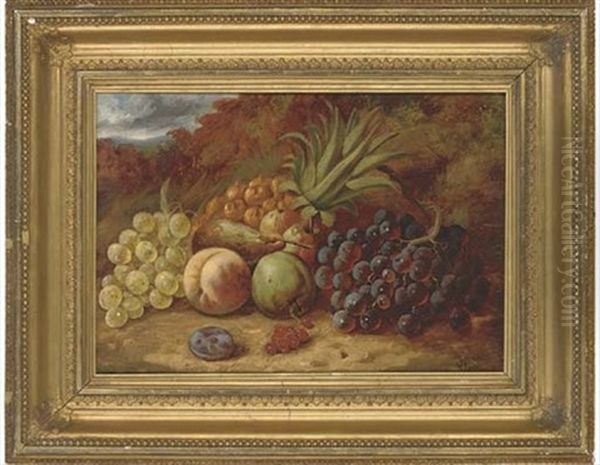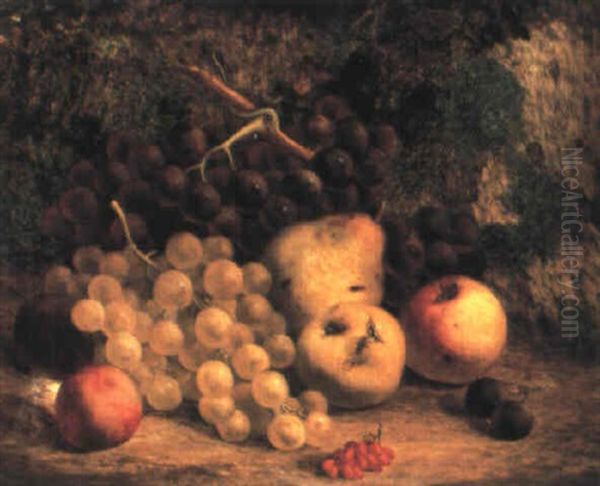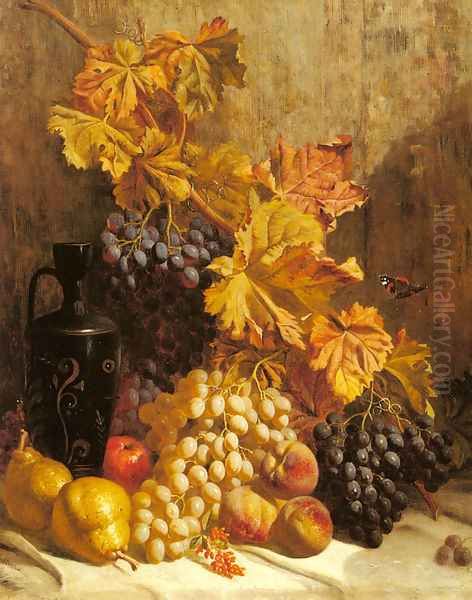The Victorian era in Britain was a period of immense artistic production, marked by diverse styles, influential movements, and a burgeoning art market. Within this vibrant landscape, numerous artists dedicated themselves to specific genres, honing their skills to capture the world around them. Among those who excelled in the meticulous art of still life was William Hughes (1842-1901), a painter celebrated for his detailed and naturalistic depictions of fruit, flowers, and nature's intimate corners. Though perhaps not as widely known today as some of his contemporaries who tackled grander historical or narrative themes, Hughes carved a distinct niche for himself, contributing significantly to the rich tradition of British still-life painting. His work, often characterized by its precision and vibrant colouring, reflects both the era's fascination with the natural world and the enduring appeal of capturing transient beauty in permanent form. He was also the father of another artist, Talbot Hughes, linking him to the continuing artistic endeavours of the next generation.
The Victorian Artistic Context
To fully appreciate William Hughes' contribution, it's essential to understand the artistic environment in which he worked. The mid-to-late 19th century was dominated by the Royal Academy of Arts, which set standards and provided the most prestigious venue for exhibition. Academic painting, often favouring historical, mythological, or literary subjects executed with polished technique, was held in high esteem. Figures like Frederic Leighton and Lawrence Alma-Tadema represented the pinnacle of this establishment success, creating works known for their classical themes and refined finish.
However, the Victorian era was also a time of artistic rebellion and innovation. The Pre-Raphaelite Brotherhood, founded in 1848 by William Holman Hunt, John Everett Millais, and Dante Gabriel Rossetti, challenged Academic conventions. They advocated a return to the perceived purity and sincerity of art before Raphael, emphasizing bright colours, intricate detail, and subjects drawn from literature, religion, and modern life, rendered with intense naturalism. Although William Hughes was not a member of the Brotherhood, the Pre-Raphaelite emphasis on detailed observation of nature undoubtedly resonated within the broader artistic climate and finds echoes in his own meticulous style.

Furthermore, the Aesthetic Movement gained prominence later in the century, championed by artists like James McNeill Whistler and Albert Moore. This movement prioritized "art for art's sake," focusing on beauty, harmony, and sensory experience over narrative or moral content. While Hughes' work remained largely representational and focused on natural subjects, the era's general appreciation for beauty and craftsmanship provided a receptive audience for skilled still-life painters. The influential critic John Ruskin, though complex in his views, was a powerful voice advocating for truth to nature and detailed observation, which lent intellectual weight to the practice of artists who depicted the natural world with fidelity.
The Tradition of Still Life
Still-life painting has a long and venerable history in European art, reaching extraordinary heights during the Dutch Golden Age with masters like Willem Kalf and Jan Davidsz. de Heem. In Britain, the genre had its own proponents, though it was sometimes considered a lesser form compared to history painting or portraiture. Nevertheless, artists consistently engaged with it, exploring its potential for demonstrating technical virtuosity and capturing the textures, colours, and forms of inanimate objects.
In the period preceding Hughes, artists like George Lance had already established a reputation for elaborate fruit compositions. Perhaps more relevant to Hughes' specific approach was the work of William Henry Hunt (often confused due to the similar name), a watercolourist highly praised by Ruskin for his incredibly detailed renderings of birds' nests, flowers, and fruit, often depicted against mossy banks. Hughes worked primarily in oil, but the shared focus on humble, natural subjects rendered with painstaking detail suggests a common sensibility, reflecting the Victorian era's burgeoning interest in natural history and the close observation of the environment. Hughes' paintings fit comfortably within this tradition, offering viewers exquisitely crafted glimpses of nature's bounty and fragility.
William Hughes: Life and Career
Biographical details about William Hughes (1842-1901) are not as extensively documented as those of some leading figures of his time. However, it is known that he was a British artist who specialized in still life. He was active during the latter half of the 19th century, a period when London was the undisputed centre of the British art world. Like many professional artists of his era, Hughes sought recognition by exhibiting his work at major public venues.

Records show that William Hughes exhibited paintings at the Royal Academy in London, the premier institution for artists seeking to establish their reputation. He also showed his work at the Suffolk Street galleries (home to the Royal Society of British Artists) and other important London exhibitions. Consistent participation in these exhibitions was crucial for an artist's visibility and commercial success, allowing them to reach potential patrons, critics, and the art-loving public. The acceptance of his works at the Royal Academy indicates that his technical skill met the high standards demanded by the institution, even if still life was not always considered the most prestigious genre.
His dedication to still life suggests a focused artistic temperament, content with exploring the subtle variations of form, colour, and texture found in natural objects. Unlike artists who diversified into portraiture or landscape, Hughes concentrated his efforts on perfecting his chosen specialty. This dedication allowed him to achieve a remarkable level of realism and detail that became the hallmark of his style. His son, Talbot Hughes (1869-1942), followed him into the art world, becoming known for historical genre paintings and later as a significant collector of historical costumes and antiques, demonstrating that an appreciation for art and history ran in the family.
Artistic Style and Technique
William Hughes' paintings are most notable for their meticulous detail and high degree of finish. He typically worked on a relatively small scale, which allowed for intense focus on the textures and surfaces of the objects he depicted. His preferred subjects often included arrangements of fruit – luscious peaches, translucent grapes, ripe plums – frequently combined with elements like flowers, nuts, leaves, and, characteristically, birds' nests, often set against a naturalistic background such as a mossy bank or simple ledge.
His technique involved careful drawing, precise brushwork, and a keen sensitivity to the effects of light. He excelled at rendering the varied textures of his subjects: the soft bloom on a peach, the smooth, reflective skin of grapes, the rough shell of a nut, the delicate structure of a feather, or the intricate weave of a bird's nest. The influence of Pre-Raphaelite principles, particularly the emphasis on 'truth to nature' and detailed rendering, is apparent in this microscopic attention to detail. While not employing the same high-keyed, almost shadowless palette of the early Pre-Raphaelites like Millais in his initial phase, Hughes used colour effectively to create a sense of vibrancy and realism.

Comparisons can be drawn with the aforementioned William Henry Hunt in terms of subject matter (especially the birds' nests and fruit on mossy banks), although Hughes worked in oils, achieving a different kind of luminosity and depth. His work might also recall the precision of earlier Dutch masters, but it possesses a distinctly Victorian sensibility, often imbued with a quiet, contemplative mood. There is less of the overt symbolism found in some Dutch still lifes, and more of a direct, almost scientific, interest in the accurate portrayal of natural specimens. Some works achieve a near trompe-l'œil effect, tempting the viewer to reach out and touch the depicted objects.
Representative Works and Subjects
While William Hughes may not have a single, iconic painting universally recognized like Rossetti's "Proserpine" or Millais' "Ophelia," his body of work consistently explores similar themes and subjects, showcasing his distinct style. Many of his paintings carry descriptive titles that clearly indicate their subject matter, such as "Still Life with Fruit and a Bird's Nest," "Peaches, Grapes and Plums on a Mossy Bank," or "Still Life with Grapes, Nuts and a Chaffinch Nest."
A typical Hughes composition might feature a cluster of ripe fruit, perhaps peaches and grapes, spilling onto a moss-covered surface. Nearby, a small, intricately rendered bird's nest, sometimes containing eggs, adds a touch of naturalistic detail and perhaps a subtle evocation of domesticity and nature's cycles. The background is often kept simple, perhaps a dark, undefined space or a suggestion of foliage, ensuring that the viewer's attention remains focused on the central arrangement. The play of light on the different surfaces – the fuzzy skin of the peach, the gleaming highlights on the grapes, the soft texture of the moss – is always a key element, demonstrating Hughes' technical prowess.
These works appealed to the Victorian taste for both naturalism and decoration. They could be appreciated for their sheer technical skill, the beauty of the subjects depicted, and their ability to bring a touch of nature's perfection into the domestic interior. While lacking the narrative complexity of figure paintings by artists like William Powell Frith or the dramatic landscapes of J.M.W. Turner (an earlier giant whose influence still lingered), Hughes' still lifes offered a different kind of artistic satisfaction – intimate, detailed, and exquisitely crafted. They stand as testament to the enduring appeal of the genre and Hughes' mastery within it.
Place within the Victorian Art World
William Hughes occupied a specific, respected place within the complex hierarchy of the Victorian art world. As a specialist in still life, he operated in a genre that, while popular with collectors, did not always garner the same critical acclaim as history painting or portraiture. Yet, his consistent exhibition record at prestigious venues like the Royal Academy demonstrates that his skill was recognized and his work found an appreciative audience.
He worked concurrently with major figures across various styles. The Pre-Raphaelites and their associates, including Holman Hunt, Millais, Rossetti, Ford Madox Brown, and Edward Burne-Jones, were exploring new approaches to narrative and symbolism. Academic giants like Leighton and Poynter upheld classical traditions. Landscape painting flourished with artists capturing both the British countryside and exotic locales. Meanwhile, the Aesthetic Movement, with Whistler at its provocative forefront, challenged the very purpose of art.
Hughes' path was quieter, focused on the patient observation and rendering of natural objects. His contemporaries in still life or detailed nature painting included figures like George Lance and William Henry Hunt, as mentioned, but also artists known for floral painting or highly detailed watercolour landscapes, such as Myles Birket Foster. Abroad, French artists like Henri Fantin-Latour were also producing exquisite flower paintings, though often with a looser, more atmospheric touch compared to Hughes' meticulous finish. Gustave Courbet's Realism also emphasized direct observation, albeit usually on a larger scale and with different subjects.
Hughes' dedication to naturalistic detail aligned with the broader Victorian interest in science and the natural world, which saw the rise of amateur botany, ornithology, and geology. His paintings, with their accurate depiction of fruit, flowers, and nests, could be seen as artistic parallels to this scientific mode of close observation. They offered a form of beauty grounded in the tangible reality of nature, rendered with a skill that invited admiration.
Legacy and Conclusion
William Hughes passed away in 1901, at the very end of the Victorian era. He left behind a body of work characterized by consistent quality, remarkable technical skill, and a deep appreciation for the beauty of the natural world. While he may not have been an innovator who drastically changed the course of art history, he was a master craftsman within his chosen genre. His detailed still lifes remain appealing for their precision, vibrant colours, and the quiet intensity of their observation.
His legacy is primarily that of a dedicated and highly accomplished Victorian still-life painter. His works continue to appear at auctions, appreciated by collectors of 19th-century British art. They serve as fine examples of the era's taste for naturalism and detailed rendering. Furthermore, his connection to his artist son, Talbot Hughes, provides a link to the ongoing story of British art and collecting into the 20th century.
In the grand narrative of art history, dominated by revolutionary movements and towering figures, specialists like William Hughes can sometimes be overlooked. However, his paintings offer a valuable window into the Victorian art world's diversity. They remind us of the importance of technical skill, the enduring appeal of still life, and the quiet beauty that can be found in the close observation of nature. William Hughes stands as a significant exponent of Victorian still-life painting, an artist whose meticulous dedication produced works of lasting charm and undeniable craftsmanship, holding their own alongside the more dramatic creations of contemporaries like Rossetti, Burne-Jones, or the grand canvases of Leighton and Alma-Tadema. His art represents a particular facet of the Victorian age's rich and varied artistic output.